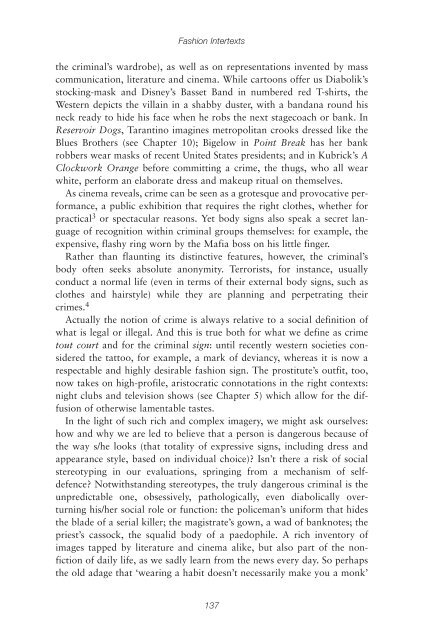You also want an ePaper? Increase the reach of your titles
YUMPU automatically turns print PDFs into web optimized ePapers that Google loves.
Fashion Intertexts<br />
the criminal’s wardrobe), as well as on representations invented by mass<br />
communication, literature and cinema. While cartoons offer us Diabolik’s<br />
stocking-mask and Disney’s Basset Band in numbered red T-shirts, the<br />
Western depicts the villain in a shabby duster, with a bandana round his<br />
neck ready to hide his face when he robs the next stagecoach or bank. In<br />
Reservoir Dogs, Tarantino imagines metropolitan crooks dressed like the<br />
Blues Brothers (see Chapter 10); Bigelow in Point Break has her bank<br />
robbers wear masks of recent United States presidents; and in Kubrick’s A<br />
Clockwork Orange before committing a crime, the thugs, who all wear<br />
white, perform an elaborate dress and makeup ritual on themselves.<br />
As cinema reveals, crime can be seen as a grotesque and provocative performance,<br />
a public exhibition that requires the right clothes, whether for<br />
practical 3 or spectacular reasons. Yet body signs also speak a secret language<br />
of recognition within criminal groups themselves: for example, the<br />
expensive, flashy ring worn by the Mafia boss on his little finger.<br />
Rather than flaunting its distinctive features, however, the criminal’s<br />
body often seeks absolute anonymity. Terrorists, for instance, usually<br />
conduct a normal life (even in terms of their external body signs, such as<br />
clothes and hairstyle) while they are planning and perpetrating their<br />
crimes. 4<br />
Actually the notion of crime is always relative to a social definition of<br />
what is legal or illegal. And this is true both for what we define as crime<br />
tout court and for the criminal sign: until recently western societies considered<br />
the tattoo, for example, a mark of deviancy, whereas it is now a<br />
respectable and highly desirable fashion sign. <strong>The</strong> prostitute’s outfit, too,<br />
now takes on high-profile, aristocratic connotations in the right contexts:<br />
night clubs and television shows (see Chapter 5) which allow for the diffusion<br />
of otherwise lamentable tastes.<br />
In the light of such rich and complex imagery, we might ask ourselves:<br />
how and why we are led to believe that a person is dangerous because of<br />
the way s/he looks (that totality of expressive signs, including dress and<br />
appearance style, based on individual choice)? Isn’t there a risk of social<br />
stereotyping in our evaluations, springing from a mechanism of selfdefence?<br />
Notwithstanding stereotypes, the truly dangerous criminal is the<br />
unpredictable one, obsessively, pathologically, even diabolically overturning<br />
his/her social role or function: the policeman’s uniform that hides<br />
the blade of a serial killer; the magistrate’s gown, a wad of banknotes; the<br />
priest’s cassock, the squalid body of a paedophile. A rich inventory of<br />
images tapped by literature and cinema alike, but also part of the nonfiction<br />
of daily life, as we sadly learn from the news every day. So perhaps<br />
the old adage that ‘wearing a habit doesn’t necessarily make you a monk’<br />
137

















